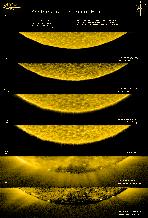Anatomy of a Coronal Hole
The south pole of the Sun seen in the light of several ultraviolet spectral
lines formed at different temperatures
Raster scan images simultaneously obtained in July 1996 by the telescope and
spectrometer SUMER (Solar Ultraviolet Measurements of Emitted Radiation) onboard
the ESA/NASA Solar and Heliospheric Observatory (SOHO). SUMER was developed at
the Max-Planck-Institut für Aeronomie (MPAE) as part of an international
cooperation. It was financially supported by DLR, CNES, NASA, ESA, MPG and PTB.
< 10 000 K
C I (1249 A)
The chromospheric network uniformly covers the southern polar region of the
Sun. The solar wind emanates from the network lanes.
30 000 K
S II (1250 A)
The network lanes are much brighter than the network cells. Strong magnetic
fields are concentrated near the lanes. The elevated network lanes contribute
to the limb-brightening effect.
190 000 K
N V (1238 A)
Spicules with typical heights of 10 000 km and larger macrospicules protrude
above the solar limb, which shows very strong brightening. For comparison
the size of the Earth is given.
250 000 K
O V (629 A)
The magnetic network closes above the cell areas. Images taken in lines
formed at higher temperatures indicate that the network structure
disappears above 600 000 K.
1 100 000 K
Mg X (624 A)
The coronal hole near the south pole and the surrounding quiet-Sun regions
can be seen. Bright points and polar plumes extending along the magnetic
field are prominent features at this temperature.
1 400 000 K
Fe XII (1242 A)
The coronal hole is very dark both on the disk and in the corona. Some
bright points are still visible. The fast solar wind is accelerated in
the darkest region and reaches a speed of 800 km/s in interplanetary space.
Downloads
- Full-size image [JPG, 144K]
- Medium-size image [JPG, 9.7K]
- Hi-resolution size image [TIF, 964K]
- Hi-resolution size document [PDF, 1.6M]
- Medium-size image [JPG, 9.7K]



